计算机导论作业2
- 格式:doc
- 大小:69.00 KB
- 文档页数:12
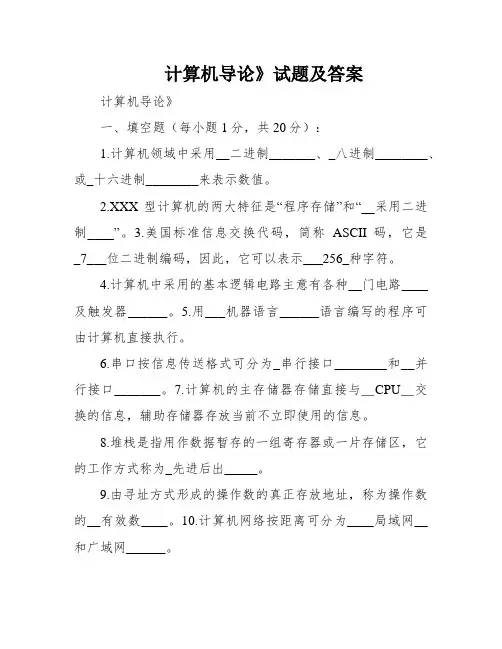
计算机导论》试题及答案计算机导论》一、填空题(每小题1分,共20分):1.计算机领域中采用__二进制_______、_八进制________、或_十六进制________来表示数值。
2.XXX型计算机的两大特征是“程序存储”和“__采用二进制____”。
3.美国标准信息交换代码,简称ASCII码,它是_7___位二进制编码,因此,它可以表示___256_种字符。
4.计算机中采用的基本逻辑电路主意有各种__门电路____及触发器______。
5.用___机器语言______语言编写的程序可由计算机直接执行。
6.串口按信息传送格式可分为_串行接口________和__并行接口_______。
7.计算机的主存储器存储直接与_CPU_交换的信息,辅助存储器存放当前不立即使用的信息。
8.堆栈是指用作数据暂存的一组寄存器或一片存储区,它的工作方式称为_先进后出_____。
9.由寻址方式形成的操作数的真正存放地址,称为操作数的__有效数____。
10.计算机网络按距离可分为____局域网__和广域网______。
11.设备管理中的设备是指计较机系统的_输入设备____、_输出设备____和___外储备器__。
12.操作系统按功能特性可分为__批处理系统____、_分时系统_____和_实时系统_____。
13.高级语言的基本元素可以分为__数,逻辑值,名字,标号,字符串_等五大类。
14.从根算起,树可以分为多个层次,树的___最大层次__称为树的深度。
15.___数据层次__是数据组织形式,反映数据之间的关系,但不涉及数据的具体内容。
16.线性表的链式储备结构中,每个元素需储备两部分信息:一部分是元素本身的信息,称之“__数据域___”;另外一部分则是该元素的直接后继元素的储备位置。
1称之“____指针域_”。
17.栈是限定在__表尾___进行插入和删除运算的线性表,其表尾称为___栈顶__,表头称为_栈尾____。
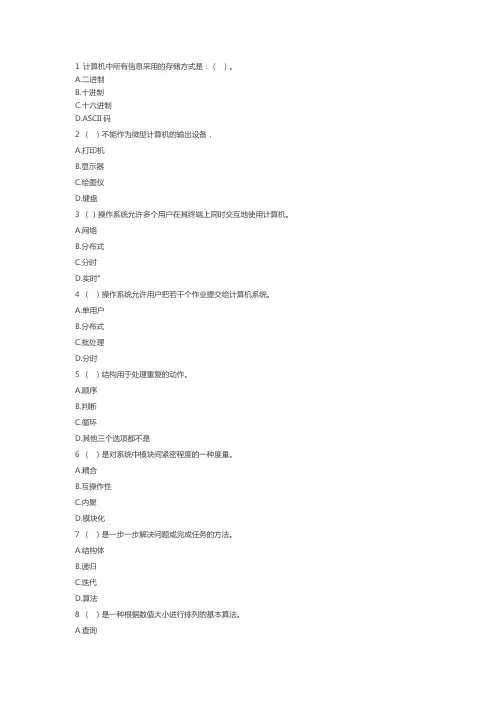
1 计算机中所有信息采用的存储方式是:()。
A.二进制B.十进制C.十六进制D.ASCII码2 ()不能作为微型计算机的输出设备,A.打印机B.显示器C.绘图仪D.键盘3 ()操作系统允许多个用户在其终端上同时交互地使用计算机。
A.网络B.分布式C.分时D.实时"4 ()操作系统允许用户把若干个作业提交给计算机系统。
A.单用户B.分布式C.批处理D.分时5 ()结构用于处理重复的动作。
A.顺序B.判断C.循环D.其他三个选项都不是6 ()是对系统中模块间紧密程度的一种度量。
A.耦合B.互操作性C.内聚D.模块化7 ()是一步一步解决问题或完成任务的方法。
A.结构体B.递归C.迭代D.算法8 ()是一种根据数值大小进行排列的基本算法。
A.查询C.查找D.递归9 ()是指在数据文件中不同记录的键值(Key)被映射到同一个地址(Address)。
A.桶B.冲突C.同义词D.链表10 ()文档是固定内容的。
A.静态B.动态C.活动D.其他三个选项都是11 ()中任何单个故障只影响其本身,而不会影响到整个网络。
A.总线型拓扑网络B.星形拓扑网络C.环形拓扑网络D.树形拓扑网络12 “黑色星期五”在逢13日的星期五发作,表明了计算机病毒除了具有潜伏性,还具有()。
A.针对性B.破坏性C.传染性D.可触发性13 1KB等于()字节。
A.1000字节B.1024字节C.2000字节D.10000字节14 1MB=()。
A.1000BB.1024BC.1000KBD.1024KB15 202.202.32.30是什么类型的IP地址:()。
A.A类B.B类D.D类16 20根地址线的寻址范围可达()。
A.512KBB.1024KBC.640KBD.4096KB17 8位字长补码运算中,下面哪个运算会发生溢出()。
A.96+32B.96-32C.-96-32D.-96+3218 实时控制将十进制的整数化为N进制整数的方法是()。
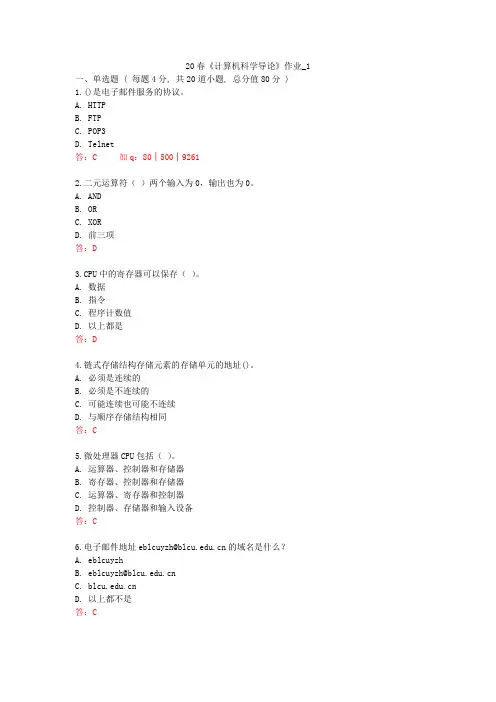
20春《计算机科学导论》作业_1一、单选题 ( 每题4分, 共20道小题, 总分值80分 )1.()是电子邮件服务的协议。
A. HTTPB. FTPC. POP3D. Telnet答:C 加q:80│500│92612.二元运算符()两个输入为0,输出也为0。
A. ANDB. ORC. XORD. 前三项答:D3.CPU中的寄存器可以保存()。
A. 数据B. 指令C. 程序计数值D. 以上都是答:D4.链式存储结构存储元素的存储单元的地址()。
A. 必须是连续的B. 必须是不连续的C. 可能连续也可能不连续D. 与顺序存储结构相同答:C5.微处理器CPU包括()。
A. 运算器、控制器和存储器B. 寄存器、控制器和存储器C. 运算器、寄存器和控制器D. 控制器、存储器和输入设备答:C6.电子邮件地址*****************.cn的域名是什么?A. eblcuyzh*******************.cnC. D. 以上都不是答:C7.操作系统中用于接收用户的输入并向操作系统解释这些请求的程序被称为()。
A. 用户界面B. 设备管理器C. 文件管理器D. 内存管理器答:A8.冯•诺依曼计算机一般都由五大功能部件组成,它们是()。
A. 运算器、控制器、存储器、输入设备和输出设备B. 运算器、累加器、寄存器、外部设备和主机C. 加法器、控制器、总线、寄存器和外部设备D. 运算器、存储器、控制器、总线和外部设备答:A9.当我们存储音乐到计算机中时,音频信号必须要()。
A. 取样B. 量化C. 编码D. 以上全部答:D10.关系模式中,满足2NF的模式,()。
A. 可能是1NFB. 必定是BCNFC. 必定是3NFD. 必定是1NF答:D11.()发明了世界上第一台加减法计算机。
A. 莱布尼茨B. 图灵C. 帕斯卡D. 冯•诺依曼答:C12.以下哪个不是输入设备?()A. 键盘B. 麦克风C. 扫描仪D. 显示器答:D13.TCP/IP协议族中()为最终用户提供服务。
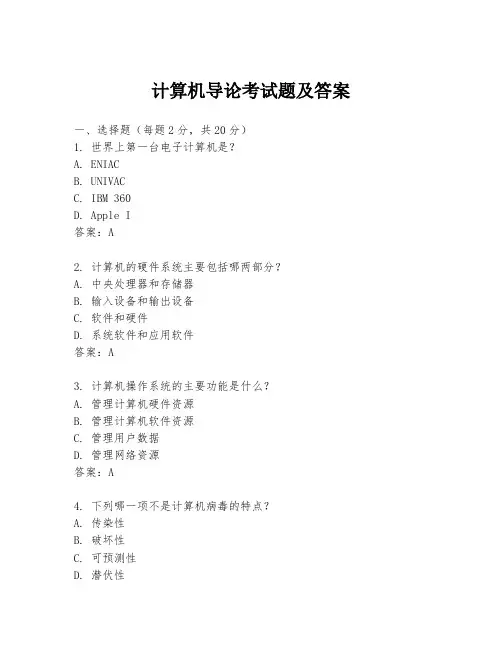
计算机导论考试题及答案一、选择题(每题2分,共20分)1. 世界上第一台电子计算机是?A. ENIACB. UNIVACC. IBM 360D. Apple I答案:A2. 计算机的硬件系统主要包括哪两部分?A. 中央处理器和存储器B. 输入设备和输出设备C. 软件和硬件D. 系统软件和应用软件答案:A3. 计算机操作系统的主要功能是什么?A. 管理计算机硬件资源B. 管理计算机软件资源C. 管理用户数据D. 管理网络资源答案:A4. 下列哪一项不是计算机病毒的特点?A. 传染性B. 破坏性C. 可预测性D. 潜伏性答案:C5. 计算机的存储器分为哪两类?A. 内存储器和外存储器B. 随机存储器和顺序存储器C. 只读存储器和可读写存储器D. 静态存储器和动态存储器答案:A6. 以下哪个选项是计算机网络的拓扑结构?A. 星型B. 总线型C. 环形D. 所有选项答案:D7. 计算机的CPU主要负责什么功能?A. 数据存储B. 数据输入C. 数据处理D. 数据输出答案:C8. 在计算机系统中,软件一般分为哪两类?A. 系统软件和应用软件B. 操作系统和数据库C. 编程语言和数据库D. 应用软件和工具软件答案:A9. 以下哪个是计算机程序设计语言的分类?A. 机器语言和汇编语言B. 高级语言和低级语言C. 汇编语言和高级语言D. 机器语言和高级语言答案:B10. 计算机的二进制数系统是基于什么原理?A. 十进制B. 十六进制C. 八进制D. 基于0和1的表示答案:D二、填空题(每题2分,共20分)1. 计算机的冯·诺依曼体系结构主要包括______、存储器、输入设备和输出设备。
答案:中央处理器2. 计算机的内存分为______和随机存取存储器(RAM)。
答案:只读存储器(ROM)3. 计算机病毒是一种______。
答案:程序4. 计算机操作系统的两种主要类型是批处理系统和______。
答案:分时系统5. 计算机的存储容量单位包括字节(Byte)、千字节(KB)、兆字节(MB)和______。
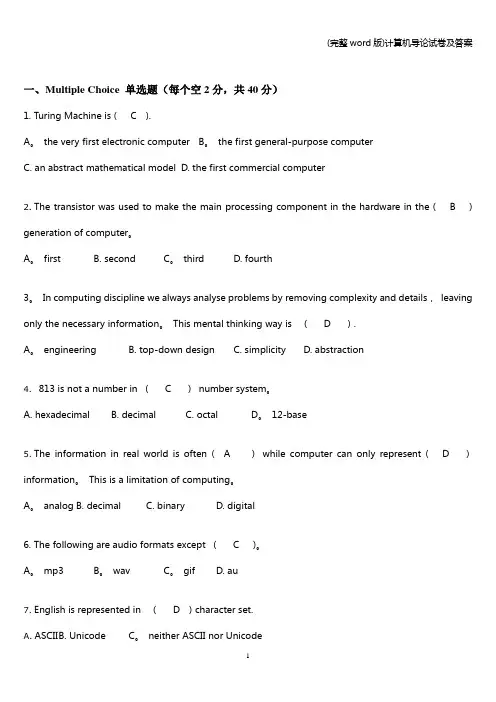
一、Multiple Choice单选题(每个空2分,共40分)1. Turing Machine is ( C ).A。
the very first electronic computer B。
the first general-purpose computerC. an abstract mathematical modelD. the first commercial computer2.The transistor was used to make the main processing component in the hardware in the ( B ) generation of computer。
A。
first B. second C。
third D. fourth3。
In computing discipline we always analyse problems by removing complexity and details,leaving only the necessary information。
This mental thinking way is ( D ).A。
engineering B. top-down design C. simplicity D. abstraction4.813 is not a number in ( C )number system。
A. hexadecimalB. decimalC. octal D。
12-base5.The information in real world is often ( A )while computer can only represent ( D )information。
This is a limitation of computing。
A。
analog B. decimal C. binary D. digital6. The following are audio formats except ( C )。
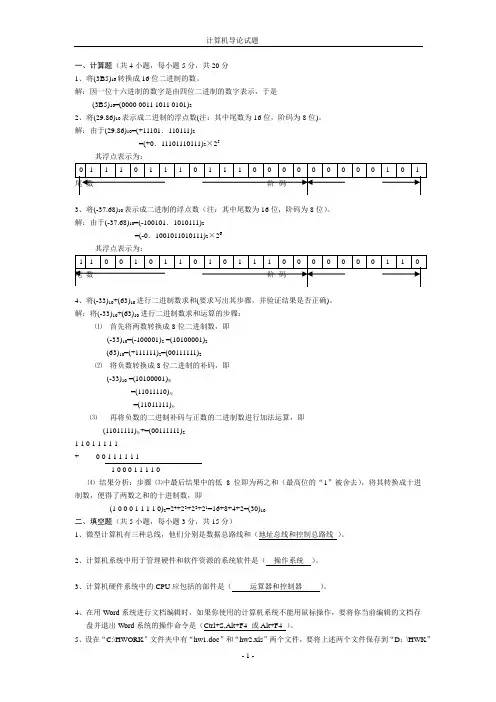
一、计算题(共4小题,每小题5分,共20分1、将(3B5)16转换成16位二进制的数。
解:因一位十六进制的数字是由四位二进制的数字表示,于是(3B5)16=(0000 0011 1011 0101)22、将(29.86)10表示成二进制的浮点数(注:其中尾数为16位,阶码为8位)。
解:由于(29.86)10=(+11101.110111)2=(+0.11101110111)2×25其浮点表示为:3、将(-37.68)10表示成二进制的浮点数(注:其中尾数为16位,阶码为8位)。
解:由于(-37.68)10=(-100101.1010111)2=(-0.1001011010111)2×26其浮点表示为:4、将(-33)10+(63)10进行二进制数求和(要求写出其步骤,并验证结果是否正确)。
解:将(-33)10+(63)10进行二进制数求和运算的步骤:⑴首先将两数转换成8位二进制数,即(-33)10=(-100001)2 =(10100001)2(63)10=(+111111)2=(00111111)2⑵将负数转换成8位二进制的补码,即(-33)10 =(10100001)原=(11011110)反=(11011111)补⑶再将负数的二进制补码与正数的二进制数进行加法运算,即(11011111)补+=(00111111)21 1 0 1 1 1 1 1+ 0 0 1 1 1 1 1 11 0 0 0 1 1 1 1 0⑷结果分析:步骤⑶中最后结果中的低8位即为两之和(最高位的“1”被舍去),将其转换成十进制数,便得了两数之和的十进制数,即(1 0 0 0 1 1 1 1 0)2=24+23+22+21=16+8+4+2=(30)10二、填空题(共5小题,每小题3分,共15分)1、微型计算机有三种总线,他们分别是数据总路线和(地址总线和控制总路线)。
2、计算机系统中用于管理硬件和软件资源的系统软件是(操作系统)。

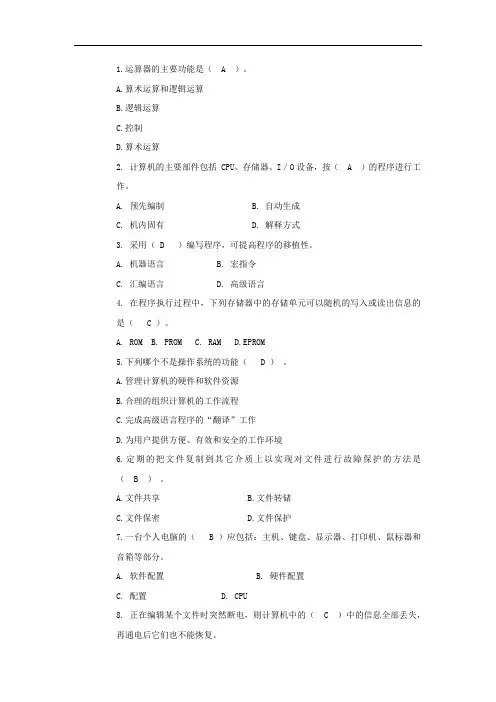
1.运算器的主要功能是( A )。
A.算术运算和逻辑运算B.逻辑运算C.控制D.算术运算2. 计算机的主要部件包括 CPU、存储器、I/O设备,按( A )的程序进行工作。
A. 预先编制B. 自动生成C. 机内固有D. 解释方式3. 采用( D )编写程序,可提高程序的移植性。
A. 机器语言B. 宏指令C. 汇编语言D. 高级语言4. 在程序执行过程中,下列存储器中的存储单元可以随机的写入或读出信息的是( C )。
A. ROMB. PROMC. RAMD.EPROM5.下列哪个不是操作系统的功能( D )。
A.管理计算机的硬件和软件资源B.合理的组织计算机的工作流程C.完成高级语言程序的“翻译”工作D.为用户提供方便、有效和安全的工作环境6.定期的把文件复制到其它介质上以实现对文件进行故障保护的方法是( B )。
A.文件共享B.文件转储C.文件保密D.文件保护7.一台个人电脑的( B )应包括:主机、键盘、显示器、打印机、鼠标器和音箱等部分。
A. 软件配置B. 硬件配置C. 配置D. CPU8. 正在编辑某个文件时突然断电,则计算机中的( C )中的信息全部丢失,再通电后它们也不能恢复。
A. ROMB. PROMC. RAMD. EPROM9. 顺序查找法适用于存储结构为( D )的线性表。
A. 顺序结构B. 链接结构C. 数组结构D. 顺序与链接结构10. 系统总线中不包括( C )。
A.数据总线B.地址总线C.进程总线D. 控制总线11. ( B )是最常用且最简单的一种数据结构。
A.栈B.线性表C.队列D. 树12.可以使用以下哪个语句实现无穷多个数的累加(C)。
A.读数-置数语句B.赋值语句C.无条件转向语句D.键盘输入语句13. 以下有关软盘的写保护说明中,错误的是( B )。
A.保护软盘上的信息B.可以写入不能读出C.可以读出不能写入D.保护软盘,使其不受病毒感染14.微型计算机的主存储器一般由(A)和()组成。
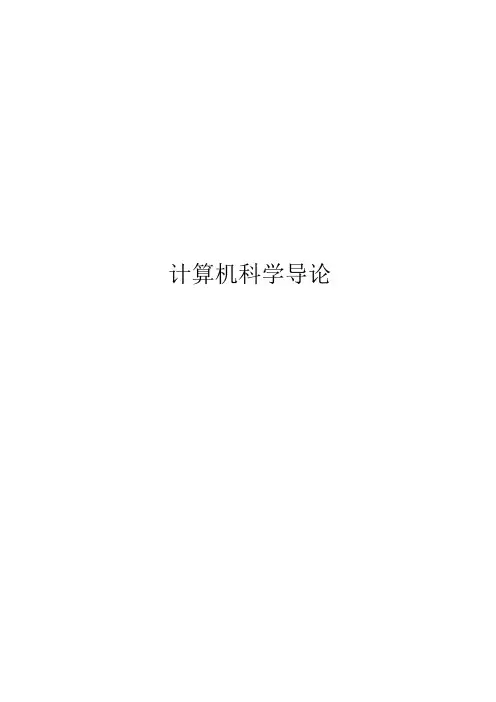
计算机科学导论第七章1应用程序和操作系统的不同点是什么?操作系统是一个程序,有利于应用程序的执行。
2操作系统的组成是什么?内存管理器,进程管理器,设备管理器,文件管理器。
3单道程序和多道程序之间有何区别?单道程序,只有一个程序在内存中。
多道程序,多个程序同时在内存中,但是计算机的资源只分配给正在运行的程序。
4分页调度和分区调度有什么区别?分区调度把内存分为若干个区,把程序整个的放入区中。
分页调度提高了分区调度的效率,在分页调度下,内存被分为大小相等的若干部分,程序也被分为大小相等的部分。
分区调度需要把程序装载到连续的内存上。
分页调度可以吧把程序装载到不连续的内存当中。
5为什么请求分页调度比常规页面调度具有更高的效率?在常规的分页调度中,整个程序必须同时在内存中,以便为程序执行。
但是在请求分页调度中,有部分页面的程序可以在内存中。
这意味着,在请求分页调度中,在给定的时间中,更多的程序可以使用计算机的资源。
6程序和作业之间有何联系?作业和进程之间有何联系?程序和进程之间有何联系?从一个程序被选中执行,到其运行结束并再次成为一个程序的这段过程中,该程序称为作业。
7程序驻留在哪里?作业驻留在哪里?进程驻留在哪里?程序和作业驻留在磁盘上,进程驻留在内存中。
8作业调度器和进程调度器有什么区别?作业调度器负责从作业中创建一个进程和终止一个进程。
进程调度器将一个进程从一个状态转入另一个状态。
9为什么操作系统需要队列?一个操作系统需要使用队列,因为在同一时间可以有许多作业和进程同时活跃。
为了共享所有的资源,队列是必要的,以确保作业和进程都得到他们需要的资源。
31一个计算机装有一个单道程序的操作系统。
如果内存容量为64MB,操作系统需要4MB的内存,那么该计算机执行一个程序可用的最大内存为多少?64-4=60MB33 70/(70+10)=87.5%34一个多道程序的操作系统用一个适当的分配计划把60MB内存分为10MB,12MB,18MB,20MB。
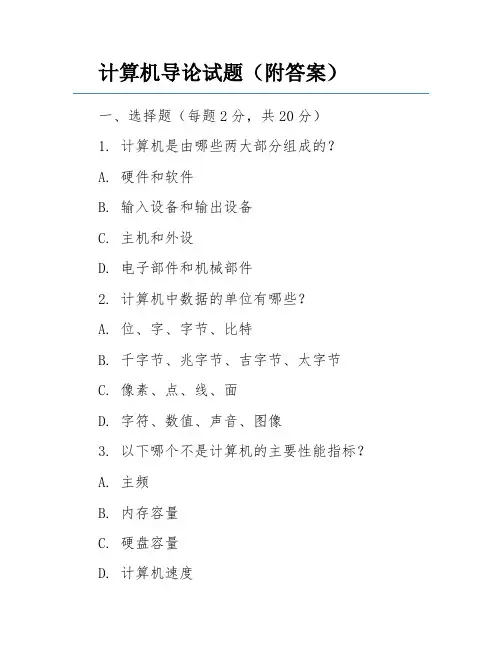
计算机导论试题(附答案)一、选择题(每题2分,共20分)1. 计算机是由哪些两大部分组成的?A. 硬件和软件B. 输入设备和输出设备C. 主机和外设D. 电子部件和机械部件2. 计算机中数据的单位有哪些?A. 位、字、字节、比特B. 千字节、兆字节、吉字节、太字节C. 像素、点、线、面D. 字符、数值、声音、图像3. 以下哪个不是计算机的主要性能指标?A. 主频B. 内存容量C. 硬盘容量D. 计算机速度4. 下列哪种输入设备用于将图像输入到计算机中?A. 扫描仪B. 数码相机C. 打印机D. 触摸屏5. 以下哪个不是计算机操作系统的主要功能?A. 资源管理B. 程序控制C. 用户界面D. 数据通信6. 下列哪种存储器是计算机中最大的存储设备?A. 硬盘B. 内存C. 光盘D. 移动存储器7. 以下哪个不是计算机网络的主要类型?A. 局域网B. 城域网C. 广域网D. 个人网8. 以下哪种协议用于互联网中的数据传输?A. TCP/IPB. HTTPC. FTPD. HTML9. 以下哪种编程语言属于高级语言?A. assemblyB. CC. HTMLD. 机器语言10. 以下哪个不是计算机软件的主要分类?A. 系统软件B. 应用软件C. 编程软件D. 工具软件二、填空题(每题2分,共20分)1. 计算机的硬件系统主要包括________、________、________、________和________等五大部分。
2. 计算机中数据的最小单位是________,常用单位有________、________、________和________等。
3. 计算机的主要性能指标包括________、________、________和________等。
4. 操作系统的四大功能模块包括________、________、________和________等。
5. 计算机网络按覆盖范围主要分为________、________和________等三种类型。
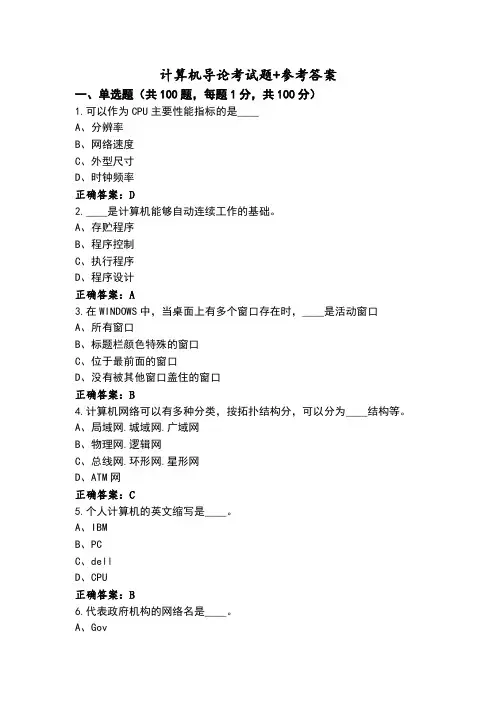
计算机导论考试题+参考答案 一、单选题(共100题,每题1分,共100分) 1.可以作为CPU主要性能指标的是____ A、分辨率 B、网络速度 C、外型尺寸 D、时钟频率 正确答案:D 2.____是计算机能够自动连续工作的基础。 A、存贮程序 B、程序控制 C、执行程序 D、程序设计 正确答案:A 3.在WINDOWS中,当桌面上有多个窗口存在时,____是活动窗口 A、所有窗口 B、标题栏颜色特殊的窗口 C、位于最前面的窗口 D、没有被其他窗口盖住的窗口 正确答案:B 4.计算机网络可以有多种分类,按拓扑结构分,可以分为____结构等。 A、局域网.城域网.广域网 B、物理网.逻辑网 C、总线网.环形网.星形网 D、ATM网 正确答案:C 5.个人计算机的英文缩写是____。 A、IBM B、PC C、dell D、CPU 正确答案:B 6.代表政府机构的网络名是____。 A、Gov B、Edu C、Com D、Net 正确答案:A 7.所谓媒体是指____。 A、计算机输入与输出信息 B、计算机屏幕显示 C、字处理软件 D、表示和传播信息的载体 正确答案:D 8.操作系统是系统资源的管理者,不能管理____。 A、计算机所有软件 B、计算机所有硬件 C、计算机所有数据 D、计算机的使用者 正确答案:D 9.TCP的主要功能是_____。 A、进行数据分组 B、保证可靠传输 C、确定数据传输路径 D、提高传输速度 正确答案:B 10.要在Web浏览器中查看某一公司的主页,必须知道____。 A、该公司的邮政编码 B、该公司的电子邮件地址 C、该公司所在的省市 D、该公司的URL 正确答案:D 11.不属于网络通信体系的硬件是____。 A、集线器 B、网桥 C、显示卡 D、网关 正确答案:C 12.将二进制数101101转换成十进制数是____。 A、90 B、91 C、49 D、45 正确答案:D 13.网页的文件格式一般为____。 A、HTML B、DOC C、TXT D、HTTP 正确答案:A 14.微型计算机中运算器的主要功能是进行____ A、算术和逻辑运算 B、初等函数运算 C、逻辑运算 D、算术运算 正确答案:A 15.计算机网络的特点是____。 A、资源共享 B、精度高 C、运算速度快 D、内存容量大 正确答案:A 16.CAD是计算机的主要应用领域,它的含义是____。 A、计算机辅助教育 B、计算机辅助测试 C、计算机辅助设计 D、计算机辅助管理 正确答案:C 17.为使因特网中的所有计算机主机能互相识别,因特网定义了两种方法来标识网上的计算机,其中之一就是____ A、存储器地址 B、HTTP协议 C、IP地址 D、计算机的编号 正确答案:C 18.关于Internet的概念叙述错误的是____。 A、Internet是局域网的一种 B、在中国称为因特网 C、Internet具有网络资源共享的特点 D、Internet即国际互连网络 正确答案:A 19.比特(bit)是数据的最小单位,一个字节有几个比特组成____。 A、16 B、4 C、8 D、2 正确答案:C 20.计算机网络按覆盖范围来分可分为____。 A、以太网和令牌网 B、局域网和以太网 C、局域网和广域网 D、广域网和以太网 正确答案:C 21.计算机的发明和发展首先是为了____。 A、人工智能 B、科学计算 C、信息处理 D、实时控制 正确答案:B 22.下列存储器中,存取信息速度最快的是____ A、光盘 B、内存 C、硬盘 D、U盘 正确答案:B 23.下列有关WWW的叙述不正确的是____。 A、它是基于一种称为Hypertext的技术 B、在Hypertext文档中有一些指向另一些文档和资源的指针 C、通过这些指针将Internet上的丰富资源连接在一起 D、不采用客户朋务器(Client/Server)方式 正确答案:D 24.计算机系统由哪几部分组成____。 A、主机和外部设备 B、主机和软件系统 C、软件系统和硬件系统 D、操作系统和硬件系统 正确答案:C 25.计算机内所有的信息都是以____数码形式表示的 A、十进制 B、八进制 C、二进制 D、十六进制 正确答案:C 26.计算机系统中除了硬件系统外,还必须有____。 A、软件系统 B、外设 C、显示器 D、应用软件 正确答案:A 27.在Windows中,用户可以同时启动多个应用程序,在启动了多个应用程序后,用户可以按组合键____在各应用程序之间进行切换。 A、Alt+Tab B、Alt+Shift C、Ctrl+Alt D、Ctrl+Esc 正确答案:A 28.用5个比特最多可以表示不同信息的个数是____。 A、5 B、32 C、IO D、16 正确答案:B 29.你想给某人通过Email发送某个小文件时,你必须____。 A、在主题上写含有小文件 B、无法办到。 C、把这个小文件复制一下,粘贴在邮件内容里 D、使用粘贴附件功能,通过粘贴上传附件完成 正确答案:D 30.下列关于URL的解释错误的是____。 A、它由4部分组成 B、它是WWW页的地址 C、它是一种网络服务 D、它的中文意思是统一资源定位器 正确答案:C 31.下列专门用于浏览网页的应用软件是____。 A、WORD B、Outlookexpress C、FrontPage D、InternetExplorer 正确答案:D 32.微处理器处理的数据基本单位为字。一个字的长度通常是____。 A、与微处理器芯片的型号有关 B、16个二进制位 C、64个二进制位 D、32个二进制位 正确答案:A 33.互联设备中Hub称为____。 A、网桥 B、服务器 C、集线器 D、网卡 正确答案:C 34.计算机病毒是一种____。 A、机器部件 B、电子元件 C、程序 D、微生物病毒体 正确答案:C 35.下列关于IP的说法错误的是____。 A、IP地址指出了该计算机连接到哪个网络上 B、IP地址是Internet上主机的数字标识 C、IP地址在Internet上是唯一的 D、IP地址由32位十进制数组成 正确答案:D 36.TCP/IP协议是一组协议,其中文全称为_____。 A、传输控制协议和网络互联协议 B、邮局协议和网络互联协议 C、传输控制协议和电子邮件协议 D、传输控制协议和文件传输协议 正确答案:A 37.连到局域网上的节点计算机必需要安装____硬件。 A、集线器 B、交换机 C、调制解调器 D、网络适配卡 正确答案:D 38.计算机之所以能实现自动连续运算,是由于采用了_____原理。 A、数字电路 B、存储程序 C、布尔逻辑 D、集成电路 正确答案:B 39.____可使计算机从外部获取信息。 A、输出设备 B、运算器 C、存储器 D、输入设备 正确答案:D 40.计算机的存储程序和程序控制的工作原理是由数学家____提出的。 A、莱布尼兹 B、帕斯卡 C、冯.诺依曼 D、图灵 正确答案:C 41.世界上首先实现存储程序的电子数字计算机是____。 A、ENIAC B、UNIVAC C、EDVAC D、EDSAC 正确答案:A 42.下列说法正确的是____。 A、计算机病毒属于生物病毒 B、外存储器包括RAM.ROM C、只要接入了计算机网络,网络信息的共享没有任何限制 D、一个完整的计算机系统包括计算机的硬件系统和软件系统 正确答案:D 43.域名中的后缀.edu表示机构所属类型为____。 A、军事机构 B、政府机构 C、教育机构 D、商业公司 正确答案:C 44.Internet上有许多应用,其中主要用来浏览网页信息的是____。 A、WWW B、FI? C、Telnet D、E-mail 正确答案:A 45.计算机的系统软件和应用软件均属于____。 A、硬件系统 B、办公系统 C、操作系统 D、软件系统 正确答案:D 46.____是可执行文件的扩展名。 A、Bak B、Exe C、Bmp D、Txt 正确答案:B *****************是一个电子邮件地址,其中hebei是____。 A、Ip地址 B、用户名 C、域名 D、计算机名 正确答案:B 48.微型计算机中必须安装的软件是____ A、辅助教学系统 B、操作系统 C、财务分析系统 D、文字处理系统 正确答案:B 49.树型结构体现的是____ A、表格的数据结构 B、文件的目录结构 C、存储空间的物理结构 D、程序的控制结构 正确答案:B 50.家用电脑既能听音乐又能看影视节目,这是利用计算机的____。 A、电脑作曲技术 B、文字处理技术 C、自动控制技术 D、多媒体技术 正确答案:D 51.多媒体PC是指____。 A、能处理声音的计算机
1、在启动WINDOWS时,桌面上会出现不同的图标。
双击______图标可浏览计算机上的所有内容。
A、收信箱B、我的电脑C、网络邻居D、回收站你的回答: B (√) 参考答案:B2、在WINDOWS中,全角方式下输入的数字或英文字母应占的字节数是______。
A、1B、2C、3D、4你的回答: B (√) 参考答案:B3、在Windows中移动窗口时,可将鼠标放在___________,然后拖动鼠标。
A、窗口内任意位置B、窗口四角或四边C、窗口标题栏上D、窗口滚动条上你的回答: C (√) 参考答案:C4、在Windows中,当程序因为某种原因陷入死循环,下列中___________方法能较好地结束该程序。
A、按Ctrl+Alt+Del键B、按Ctrl+Del键C、按Alt+Del键D、直接Reset计算机结束该程序地运行你的回答: A (√) 参考答案:A5、在Windows中,要表示第三个字母为A,扩展名为txt的一类文件,正确的命名是:A、*A*.txtB、??A*.txtC、**A?.txtD、?A?.txt你的回答: B (√) 参考答案:B6、在Windows中,用户同时打开的多个窗口可以层叠式或平铺式排列,要想改变窗口的排列方式,应进行的操作是。
A、用鼠标右键单击“任务栏”空白处,然后在弹出的快捷菜单中选取要排列的方式B、用鼠标右键单击桌面空白处,然后在弹出的快捷菜单中选取要排列的方式C、打开“资源管理器”窗口,选择其中的“查看”菜单下的“排列图标”项D、打开“我的电脑”窗口,选择其中的“查看”菜单下的“排列图标”项你的回答: A (√) 参考答案:A7、把Windows的窗口和对话框作一比较,窗口可以移动和改变大小,而对话框。
A、仅可以移动,不能改变大小B、既不能移动,也不能改变大小C、仅能改变大小,不能移动D、既能移动,也能改变大小你的回答: A (√) 参考答案:A8、在Windows 2000中选取某一菜单后,若菜单项后面带有省略号(…),则表示( )。
第一章 一、简答题 1 计算机系统是一种能够按照事先存储的统包括硬件和软件两大部分。
2、解释冯·诺依曼所提出的“存储程序”概念。
把程序和数据都以二进3运算速度快`精度高有市具有逻辑判断和记忆能力 计算机有准确的动决定下一步应该执行的指令。
高度的自动化和灵活性 计算机采取存储程序方实现了高度的自动化和灵活性。
4 1计算 2 (3) 实时控制 4 5辅助工程和辅助教育 6 5、计算机发展中各个阶段的主要特第一代计算机 特征是采用电子管作为主要元器件 第二代计算机特征是采用晶体管作为主要器件 第三代计算机 特征是半导体中小规模集成电路 第四代计算机 特征是大规模和超大规模集成电路 6信息化社会的主要特1·建立完善的信息基础设施 2·采用现金的信息技术 3·建立广泛的信息产业 4·拥有高素质的信息人才 5·构建良好的信息环境 7、信息化社会在信息化社会中所需要的计算机人仅需要开发型人才而且需要维护型、服务型、操作型的人才。
要求计算机人才具8、说明计算机科学与技术学科的知识体系及知识领域、知识单元和知识点的含义。
9计算机科学技术的研究范畴主要包括计算机理论、硬件、软件、网络及其应用等。
二、选择题 1 计算机是接受命令2 冯·诺依曼的主要贡献是【提出了存储程序概念】 3计算机】 4 计算机硬件由55个基本组成部分 5 其内容在电源断掉以后就消失又被暂时存储器的条件是【内存储器】 6 拥有高度结构化和组织化的数据文件被称为【数据库】 7 计算机系统必须具备的两部分是【硬件和软件】 8 计算机处理的5910 Inteinet 了社会信息化的进程。
11 Internet 的核心功能是实现【全球信息共享】 12 信息高速公路是指【国家信息基础设施】第二章一简答题。
1 3按进位的12 1 3由每个数字所在的为止决定。
210+0=0 0+1=1 1+0=1 1+1=10 (2)乘法运算法则0*0=0 0*1=0 1*0=0 1*1=1 3 十进制整数转换为非十进制证书的规则是1余为高。
11. 设备管理中的设备是指计算机系统的12. 操作系统按功能特征可分为 ______13. 高级语言的基本元素可以分为 ____14. 从根算 ___ 、____ 和_____ 。
____ 和_____ 。
____ 、 ____ 、______ 和____ 等五大类。
计算机导论》试题和答案一、填空题(每小题 1 分,共20 分):1. 计算机领域中采用 ________ 、 _________ 、或 _______ 来表示数值。
2. 冯•诺依曼型计算机的两大特征是“程序存储”和“_____ ”。
3. 美国标准信息交换代码,简称ASCII 码,它是_ 位二进制编码,因此,它可以表示种字符。
4. 计算机中采用的基本逻辑电路主意有各种_______ 及_____ 。
5. 用 ________ 语言编写的程序可由计算机直接执行。
6. 串口按信息传送格式可分为 __________ 和 _______ 。
7. 计算机的主存储器存储直接与—交换的信息,辅助存储器存放当前不立即使用的信息。
8. 堆栈是指用作数据暂存的一组寄存器或一片存储区,它的工作方式称为____ 。
9. 由寻址方式形成的操作数的真正存放地址,称为操作数的 ____ 。
10. 计算机网络按距离可分为 ______ 和 ____15. __ 是数据组织形式,反映数据之间的关系,但不涉及数据的具体内容。
16. 线性表的链式存储结构中,每个元素需存储两部分信息:一部分是元素本身的信息,称之“ _ _ _ _ _”;另一部分则是该元素的直接后继元素的存储位置,称之“_____ ”。
17. 栈是限定在_ _ _ _ _进行插入和删除运算的线性表,其表尾称为___ ,表头称为____18. 用编译方法在计算机上执行用高级语言编写的程序,可分为两个阶段: ___ 和_____19. 从资源管理的角度,操作系统要实现对计算机系统的四类资源管理,即 ____ 、___ _____ 和_____ 。
《计算机导论》试题和答案一、填空题(每小题1分,共20分):1. 计算机领域中采用_________、_________、或_________来表示数值。
2. 冯·诺依曼型计算机的两大特征是“程序存储”和“______”。
3. 美国标准信息交换代码,简称ASCII码,它是____位二进制编码,因此,它可以表示 ____种字符。
4. 计算机中采用的基本逻辑电路主意有各种______及______。
5. 用_________语言编写的程序可由计算机直接执行。
6. 串口按信息传送格式可分为_________和_________。
7. 计算机的主存储器存储直接与__交换的信息,辅助存储器存放当前不立即使用的信息。
8. 堆栈是指用作数据暂存的一组寄存器或一片存储区,它的工作方式称为______。
9. 由寻址方式形成的操作数的真正存放地址,称为操作数的______。
10. 计算机网络按距离可分为______和______。
11. 设备管理中的设备是指计算机系统的_____、_____和_____。
12. 操作系统按功能特征可分为______、______和______。
13. 高级语言的基本元素可以分为____、______、______、______和______等五大类。
14. 从根算起,树可以分为多个层次,树的_____称为树的深度。
15. _____是数据组织形式,反映数据之间的关系,但不涉及数据的具体内容。
16. 线性表的链式存储结构中,每个元素需存储两部分信息:一部分是元素本身的信息,称之“_____”;另一部分则是该元素的直接后继元素的存储位置,称之“_____”。
17. 栈是限定在_____进行插入和删除运算的线性表,其表尾称为_____,表头称为_____。
18. 用编译方法在计算机上执行用高级语言编写的程序,可分为两个阶段: _____和_____。
19. 从资源管理的角度,操作系统要实现对计算机系统的四类资源管理,即______、______、______和______。
Test Bank—Chapter Two (Data Manipulation)The following table is from Appendix C of the text. It is included here so that it can be incorporated in tests for student reference. Questions in this test bank refer to this table as the “language description table.”Op-code Operand Description1 RXY LOAD the register R with the bit pattern found in the memory cell whose address is XY.Example: 14A3 would cause the contents of the memory cell located at address A3 to be placedin register 4.2 RXY LOAD the register R with the bit pattern XY.Example: 20A3 would cause the value A3 to be placed in register 0.3 RXY STORE the bit pattern found in register R in the memory cell whose address is XY.Example: 35B1 would cause the contents of register 5 to be placed in the memory cell whoseaddress is B1.4 0RS MOVE the bit pattern found in register R to register S.Example: 40A4 would cause the contents of register A to be copied into register 4.5 RST ADD the bit patt erns in registers S and T as though they were two’s complement representationsand leave the result in register R.Example: 5726 would cause the binary values in registers 2 and 6 to be added and the sum placedin register 7.6 RST ADD the bit patterns in registers S and T as though they represented values in floating-pointnotation and leave the floating-point result in register R.Example: 634E would cause the values in registers 4 and E to be added as floating-point valuesand the result to be placed in register 3.7 RST OR the bit patterns in registers S and T and place the result in register R.Example: 7CB4 would cause the result of ORing the contents of registers B and 4 to be placed inregister C.8 RST AND the bit patterns in register S and T and place the result in register R.Example: 8045 would cause the result of ANDing the contents of registers 4 and 5 to be placed inregister 0.9 RST EXCLUSIVE OR the bit patterns in registers S and T and place the result in register R.Example: 95F3 would cause the result of EXCLUSIVE ORing the contents of registers F and 3 tobe placed in register 5.A R0X ROTATE the bit pattern in register R one bit to the right X times. Each time place the bit thatstarted at the low-order end at the high-order end.Example: A403 would cause the contents of register 4 to be rotated 3 bits to the right in a circularfashion.B RXY JUMP to the instruction located in the memory cell at address XY if the bit pattern in register Ris equal to the bit pattern in register number 0. Otherwise, continue with the normal sequence ofexecution. (The jump is implemented by copying XY into the program counter during the executephase.)Example: B43C would first compare the contents of register 4 with the contents of register 0. Ifthe two were equal, the pattern 3C would be placed in the program counter so that the nextinstruction executed would be the one located at that memory address. Otherwise, nothing wouldbe done and program execution would continue in its normal sequence.C 000 HALT execution.Example: C000 would cause program execution to stop.Multiple Choice Questions1. Which of the following is not contained in a CPU?A. Instruction registerB. Program counterC. General-purpose registerD. Memory cellANSWER: D2. Which of the following instructions (as described in the language description table) changes the contents ofa memory cell?A. 10ABB. 20ABC. 30ABD. 40ABANSWER: C3. Which of the following instructions (as described in the language description table) places 00000000 in register A?A. 1A00B. 2A00C. 3A00D. 200AANSWER: B4. Which of the following instructions (as described in the language description table) places 00000000 in register 5?A. 25FFB. 9555C. 15FFD. 8555ANSWER: B5. Which of the following instructions (as described in the language description table) will not change the contents of register 5?A. 1508B. 2508C. A503D. A508ANSWER: D6. Which of the following instructions (as described in the language description table) is equivalent to requesting that register A be rotated to the left by three bits?A. AA05B. AA03C. AA08D. AA01ANSWER: A7. Which of the following instructions (as described in the language description table) changes the contents of register 7?A. 4077B. 4075C. 4057D. 37BBANSWER: C8. Which of the following is not a form of parallel processing?A. SISDB. MIMDC. SIMDANSWER: A9. In which of the following locations is information most readily available for manipulation by the CPU?A. General-purpose registersB. Main memoryC. Mass storageANSWER: A10. The bus in a computer is an example of which form of communication?A. SerialB. ParallelC. Neither A nor BANSWER: B11. Which of the following instructions does not fall in the category of arithmetic/logic instructions?A. ROTATEB. ADDC. ORD. JUMPANSWER: D12. Which of the following instructions falls in the category of data transfer instructions?A. LOADB. ANDC. ROTATED. JUMPANSWER: A13. Which of the following is not a component of a machine instruction?A. Op-codeB. PortC. OperandANSWER: B14. Which of the following is not an activity performed entirely within a CPU?A. Fetch instructionsB. Perform Boolean operationsC. Perform arithmetic operationsD. Move data between registersANSWER: A15. What mask in register F would cause the instruction 8AAF (refer to the language description table) to puta 0 in the most significant bit of register A without disturbing the other bits?A. 11111110B. 00000001C. 10000000D. 011111111ANSWER: D16. What mask in register F would cause the instruction 7AAF (refer to the language description table) to puta 1 in the most significant bit of register A without disturbing the other bits?A. 11111110B. 00000001C. 10000000D. 011111111ANSWER: C17. Which of the following instructions will not produce the same result as the other two? (Refer to the language description table.)A. A502B. A506C. A50AANSWER: B18. Which of the following instructions will not produce the same result as the other two? (Refer to the language description table.)A. 9555B. 2500C. 1500ANSWER: C19. If register A contained the pattern 00000000, which of the following instructions could alter the contents of register 0? (Refer to the language description table.)A. 700AB. 800AC. 900AANSWER: B20. Which of the following instructions (as described in the language description table) is essentially an unconditional jump?A. B033B. B133C. B233D. B333ANSWER: AFill-in-the-blank/Short-answer Questions1. If register 0 contains the pattern 01101001 before executing the instruction A003 (see the language description table), what bit pattern will be in register 0 after the instruction is executed?____________ANSWER: 001011012. If registers 5 and 6 contain the bit patterns 5A and 58 respectively, what bit pattern will be in register 4 after executing the instruction 5456? (See language description table.)____________ANSWER: B23. If registers 5 and 6 contain the bit patterns 5A and 58 respectively, what bit pattern will be in register 4 after executing the instruction 6456? (See language description table and assume a floating-point format in which the most significant bit is the sign bit, the next three bits represent the exponent field in excess notation, and the last four bits represent the mantissa.)____________ANSWER: 694. Write the answer to each of the following logic problems.10101010 10101010 10101010AND 11110000 OR 11110000 XOR 11110000ANSWER: 10100000, 11111010, and 010110105. Suppose registers E and F contained AA and CC, respectively. What bit pattern would be in register D after executing each of the following instructions (see language description table)?A. 7DEF __________B. 8DEF __________C. 9DEF __________ANSWER: A. EE B. 88 C. 666. If registers 0, 1, and 2 contain the patterns A5, A5, and B7, respectively, which of the following instructions will result in a jump to location AA? (Refer to the language description table.)A. B0AAB. B1AAC. B2AA____________ANSWER: A and B7. If registers 0 and 1 contain the patterns B5 and F0, respectively, what will be in register 1 after executing each of the following instructions? (Refer to the language description table.)A. A102 __________B. 4001 __________C. 4010 __________ANSWER: A. 3C B. B5 C. F08. Suppose the instruction B1A5 (as described in the language description table) is stored in main memory at addresses E0 and E1. Moreover, suppose registers 0 and 1 both contain the pattern FF. What value will be in the CPU’s program counter imm ediately after executing the instruction?____________ANSWER: A59. Suppose the instruction B1A5 (as described in the language description table) is stored in main memory at addresses E0 and E1. Moreover, suppose registers 0 and 1 contain the patterns FF and 75, respectively. What value will be in the CPU’s program counter immediately after executing the instruction?____________ANSWER: E210. Encode each of the following commands in terms of the machine language described in the language description table.A. __________ LOAD register 7 with the value A5.B. __________ LOAD register 7 with the contents of the memory cell at address A5.C. __________ ADD the contents of registers 5 and 6 as thought they were values in two’scomplement notation and leave the result in register 4.D. __________ OR the contents of registers 5 and 6, leaving the result in register 4. ANSWER: A. 27A5 B. 17A5 C. 5456 (or 5465) D. 7456 (or 7465)11. Encode each of the following commands in terms of the machine language described in the language description table.A. __________ ROTATE the contents of register 7 to the right 5 bit positions.B. __________ JUMP to the instruction at address B2 if the content of register 2 equals that ofregister 0.C. __________ ADD the contents of registers 5 and 6 as thought they were values in floating-point notation and leave the result in register 4.D. __________ AND the contents of registers 5 and 6, leaving the result in register 4. ANSWER: A. A705 B. B2B2 C. 6456 (or 6465) D. 8456 (or 8465)12. Decode each of the following instructions that were encoded using the language description table.A. 4034 ___________________________________________________________B. 8023 ___________________________________________________________C. B288 ___________________________________________________________D. 2345 ___________________________________________________________ ANSWER: A. MOVE the contents of register 3 to register 4.B. AND the contents of registers 2 and 3, leaving the result in register 0.C. JUMP to the instruction at address 88 if the contents of register 2 equals that of register 0.D. LOAD register 3 with the pattern 45.13. Decode each of the following instructions that were encoded using the language description table.A. A004 ___________________________________________________________B. 1234 ___________________________________________________________C. 5678 ___________________________________________________________D. C000 ___________________________________________________________ ANSWER: A. ROTATE the contents of register 0 to the right by four bit positions.B. LOAD register 2 with the bit pattern from the memory cell at address 34.C. ADD the contents of registers 7 and 8 as though they represented values encoded in two’scomplement notation and leave the result in register 6.D. HALT.14. The following table shows a portion of a machine's memory containing a program written in the language described in the language description table. Answer the questions below assuming that the machine is started with its program counter containing 00.address content00 2101 0B02 1403 0404 C005 00A. What bit pattern will be in register 4 when the machine halts?___________B. What bit pattern will be in register 1 when the machine halts?___________ANSWER: A. C0 B. 0B15. The following table shows a portion of a machine's memory containing a program written in the language described in the language description table. Answer the questions below assuming that the machine is started with its program counter containing 00.address content address content00 10 07 0001 02 08 C002 24 09 0003 04 0A C004 B4 0B 0005 0A 0C C006 C0 0D 00A. What bit pattern will be in register 0 when the machine halts?___________B. What bit pattern will be in register 4 when the machine halts?___________C. What bit pattern will be in the program counter when the machine halts?___________ANSWER: A. 24 B. 04 C. 0816. The following table shows a portion of a machine's memory containing a program written in the language described in the language description table. Answer the questions below assuming that the machine is started with its program counter containing 00.address content address content00 25 07 0001 03 08 C002 20 09 0003 F9 0A C004 53 0B 0005 05 0C C006 33 0D 00A. What bit pattern will be in register 5 when the machine halts?____________B. What bit pattern will be in register 0 when the machine halts?____________C. What bit pattern will be in register 3 when the machine halts?____________D. What bit pattern will be at memory location 00 when the machine halts?____________ANSWER: A. 03 B. F9 C. FC D. FC17. The following table shows a portion of a machine's memory containing a program written in the language described in the language description table. Answer the questions below assuming that the machine is started with its program counter containing 00.address content address content00 25 07 0001 03 08 3402 A5 09 0403 02 0A B004 35 0B 0305 03 0C C006 24 0D 00A. What bit pattern will be in register 5 when the machine halts?____________B. What bit pattern will be in the program counter when the machine halts?____________C. What bit pattern will be at memory location 04 when the machine halts?____________ANSWER: A. C0 B. 05 C. 0018. Below is a short routine written in the machine language described in the language description table and stored in a machine's memory beginning at address 50. What must be in the memory cell at address 40 to avoid an unending loop?Address Instruction50 200152 134054 833056 B35258 ...________________________________________ANSWER: Any bit pattern whose least significant bit is 019. The following table shows a portion of a machine's memory containing a program written in the language described in the language description table. Answer the questions below assuming that the machine is started with its program counter containing 00.address content address content00 B0 07 C001 03 08 0002 25 09 2303 B0 0A B004 0C 0B 0305 C0 0C B006 00 0D 07A. How many instructions will be executed before the machine halts?____________B. What bit pattern will be in the program counter when the machine halts?____________ANSWER: A. 4 B. 0920. The following table shows a portion of a machine's memory containing a program written in the language described in the language description table. Answer the questions below assuming that the machine is started with its program counter containing 00.address content address content00 20 07 1201 02 08 B202 21 09 0C03 01 0A B004 22 0B 0605 01 0C C006 52 0D 00A. What bit pattern will be in register 2 when the machine halts?___________B. How many times will the instruction at address 06 be executed before the machine halts?___________ANSWER: A. 02 B. 2Vocabulary (Matching) QuestionsThe following is a list of terms from the chapter along with descriptive phrases that can be used to produce questions (depending on the topics covered in your course) in which the students are ask to match phrases and terms. An example would be a question of the form, “In the blank next to each phrase, write the term from the following list that is best described by the phrase.”Term Descriptive Phraseop-code The part of a machine instruction that identifies the basic operation tobe performedmachine language A means of encoding instructionsmachine cycle The process of fetching and executing instructions that is repeatedover and over by the CPUregister A location within a CPU for temporary data storagemasking A means of isolating particular bits within a bit patternbus The communication path between a CPU and main memorymemory-mapped I/O The technique of communicating with peripheral devices as thoughthey were memory cellspipeling A means of processing more than one instruction at a timestored-program concept A technique of recording programs in main memory from where theycan be accessed and executedprogram counter Used by the CPU to keep its place in the program being executedmain memory from where they can be retrieved and executed controller The interface between “a computer” and a peripheral devic emodem Modulator-demodulatorport The “connection” through which a CPU communicates with aperipheral deviceUSB A communication system by which a variety of peripheral devices canbe connected to a computerclock Used to synchronize the operations within a computerstatus word A means by which a peripheral device reports its conditionbps A means of measuring the rate of data transferCISC A computer whose machine language contains many complexinstructionshandshaking Refers to the two-way communication that takes place between acomputer an a peripheral devicebandwidth Refers to a communication path’s maximum capacity for transferringdataDMA The ability of a peripheral device to communicate directly with acomputer’s main memoryGeneral Format Questions1. Describe the machine cycle.ANSWER: Fetch an instruction and increment the program counter, decode the instruction, and execute the instruction.2. Explain the concept of throughput and techniques by which throughput is increased.ANSWER: Throughput measures the amount of “work” performed by a computer rather than the speed with which the computer executes instructions. Throughput is increased by introducing parallel processing techniques such as pipeling or parallel processing via multiprocessor designs.3. What is the difference between a conditional jump instruction and an unconditional jump instruction? ANSWER: A conditional jump instruction will result in a “jump” to another location only under certainco nditions whereas an unconditional jump instruction will result in a “jump” to another location under all conditions.4. The following is a routine encoded in the machine language described in the language description table. Explain (in a single sentence) what the routine does. (Explain what the entire routine does as a unit rather than reciting what each instruction does.)12A032B012A132B112A232B2ANSWER: It copies the contents of memory cells A0 through A2 to memory cells B0 through B2.5. The following is a routine encoded in the machine language described in the language description table. Explain (in a single sentence) what the routine does. (Explain what the entire routine does as a unit rather than reciting what each instruction does.)210F12A0821232A0ANSWER: It places 0s in the four most significant bits of memory cell A0 without disturbing the other four bits.6. The following table shows a portion of a machine's memory containing a program written in the language described in the language description table. What will happen if the machine is started with its program counter containing 00?address content00 2101 B002 3103 0404 C005 00ANSWER: The machine will change the last instruction to a jump instruction and continue to repeat the same routine over and over.7. Using the machine language described in the language description table, write a sequence of instructions that will place the pattern FF in the memory cell at address A0.ANSWER: 2XFF, 3XA0 (where X can be any register but must be the same in both instructions)8. Using the machine language described in the language description table, write a sequence of instructions that will place a 1 in the most significant bit of the memory cell at address A0 without disturbing the other bits.ANSWER: 2X80, 1YA0, 7YXY, 3YA0 (where X and Y can be any distinct registers)9. Using the machine language described in the language description table, write a sequence of instructions that will add five to the value (represented in two’s complement notation) stored at memory address A0. ANSWER: 2X05, 1YA0, 5YXY, 3YA0 (where X and Y can be any distinct registers)10. Using the machine language described in the language description table, write a sequence of instructions that will subtract one from the value (represented in two’s complement notation) stored at memory address A0.ANSWER: 2XFF, 1YA0, 5YXY, 3YA0 (where X and Y can be any distinct registers)11. Using the machine language described in the language description table, write a sequence of instructions that will shift the contents of the memory cell at address A0 three bit positions to the right while filling the holes at the left end with 0s.ANSWER: 1XA0, AX03, 2Y1F, 8XXY, 3XA0 (where X and Y can be any distinct registers)。